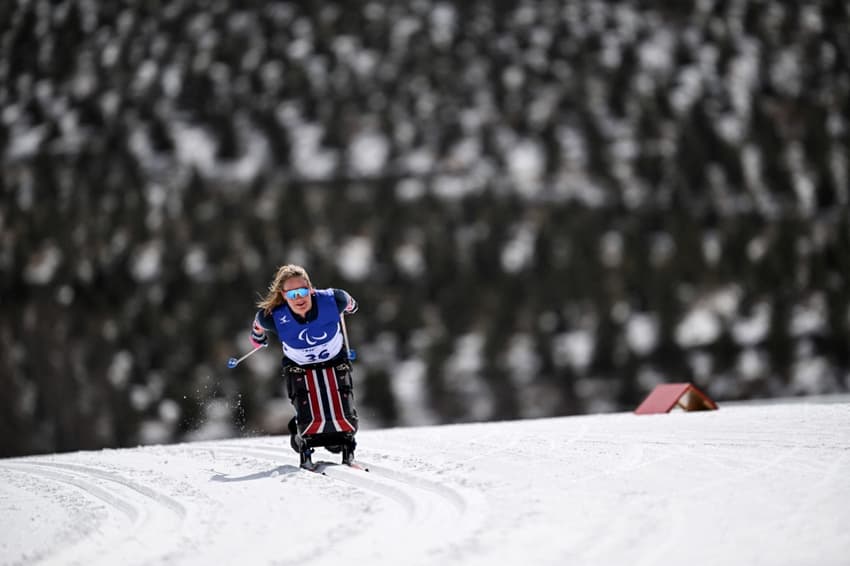Norway paralympians fear for future of winter sports as climate change takes hold

As Norway's winter paralympians prepare to return home from Beijing, they fear the effects of climate change and how a lack of snowfall could inhibit training for the Milano-Cortina Games in 2026.
When she should have been skiing during Norway's traditional snow season last winter, Birgit Skarstein was still rowing a scull boat on lakes that usually freeze over.
The Paralympian, who rows at summer games and skis at the winter edition, says she is on the frontline of observing the effects of climate change in Norway.
"This year I wasn't able to ski on really good tracks until the end of January," Skarstein told AFP, adding that normally the natural snowfall comes in November.
"I was hunting mountain tops. Over November, December, January I was moving from mountain top to mountain top to find snow and it was only artificial snow."
With temperatures rising globally, the 33-year-old cautions about the future of snow sports.
"Everybody who loves snow and everybody who loves winter sports should care about climate change," she said.
"We were rowing until New Year's... it was crazy," she says, pointing out that venues for winter-sport training are becoming increasingly scarce.

Norways Birgit Skarstein competes in the womens long distance sitting cross-country skiing event on March 6, 2022 at the Zhangjiakou National Biathlon Centre, during the Beijing 2022 Winter Paralympic Games. Photo: LILLIAN SUWANRUMPHA / AFP
Both natural snowfall and the amount of water available for artificial snow are diminishing around the world, said Climate Council of Australia research director Dr Martin Rice.
"In fact, of the 21 venues used for the Winter Olympic Games since 1924 and Paralympic Games since 1976, only 10 will have the 'climate suitability' and natural snowfall levels to host an event by 2050," he told AFP.
Athletes in T-shirts
At the Beijing Winter Paralympics, Nordic and alpine skiing events have taken place on slopes using only artificial snow.
Some athletes even wore T-shirts as they ploughed through the slushy snow as temperatures reached up to six degrees above freezing at Wednesday's cross-country skiing event at Zhangjiakou.
"You pull and you feel like you're stuck in glue," said Skarstein, who raced in short sleeves.
Paralympians recalled they had endured similar warm conditions at PyeongChang 2018 and Sochi 2014
International Paralympic Committee President Andrew Parsons said organisers were aware of the growing impact of climate change -- particularly increased heat and issues with snow quality.
"How this impacts on the Paralympic Winter Games is something that we have to monitor," he told AFP.
"We need to offer the best conditions for the athletes and the best experience," he said.
The Olympic and Paralympic movements are conscious of their carbon footprints. The International Olympic Committee announced it will cut its direct and indirect greenhouse gas emissions by 50 per cent by 2030. It will also require Games to be "climate positive" from 2030.
Comments
See Also
When she should have been skiing during Norway's traditional snow season last winter, Birgit Skarstein was still rowing a scull boat on lakes that usually freeze over.
The Paralympian, who rows at summer games and skis at the winter edition, says she is on the frontline of observing the effects of climate change in Norway.
"This year I wasn't able to ski on really good tracks until the end of January," Skarstein told AFP, adding that normally the natural snowfall comes in November.
"I was hunting mountain tops. Over November, December, January I was moving from mountain top to mountain top to find snow and it was only artificial snow."
With temperatures rising globally, the 33-year-old cautions about the future of snow sports.
"Everybody who loves snow and everybody who loves winter sports should care about climate change," she said.
"We were rowing until New Year's... it was crazy," she says, pointing out that venues for winter-sport training are becoming increasingly scarce.

Both natural snowfall and the amount of water available for artificial snow are diminishing around the world, said Climate Council of Australia research director Dr Martin Rice.
"In fact, of the 21 venues used for the Winter Olympic Games since 1924 and Paralympic Games since 1976, only 10 will have the 'climate suitability' and natural snowfall levels to host an event by 2050," he told AFP.
Athletes in T-shirts
At the Beijing Winter Paralympics, Nordic and alpine skiing events have taken place on slopes using only artificial snow.
Some athletes even wore T-shirts as they ploughed through the slushy snow as temperatures reached up to six degrees above freezing at Wednesday's cross-country skiing event at Zhangjiakou.
"You pull and you feel like you're stuck in glue," said Skarstein, who raced in short sleeves.
Paralympians recalled they had endured similar warm conditions at PyeongChang 2018 and Sochi 2014
International Paralympic Committee President Andrew Parsons said organisers were aware of the growing impact of climate change -- particularly increased heat and issues with snow quality.
"How this impacts on the Paralympic Winter Games is something that we have to monitor," he told AFP.
"We need to offer the best conditions for the athletes and the best experience," he said.
The Olympic and Paralympic movements are conscious of their carbon footprints. The International Olympic Committee announced it will cut its direct and indirect greenhouse gas emissions by 50 per cent by 2030. It will also require Games to be "climate positive" from 2030.
Join the conversation in our comments section below. Share your own views and experience and if you have a question or suggestion for our journalists then email us at [email protected].
Please keep comments civil, constructive and on topic – and make sure to read our terms of use before getting involved.
Please log in here to leave a comment.